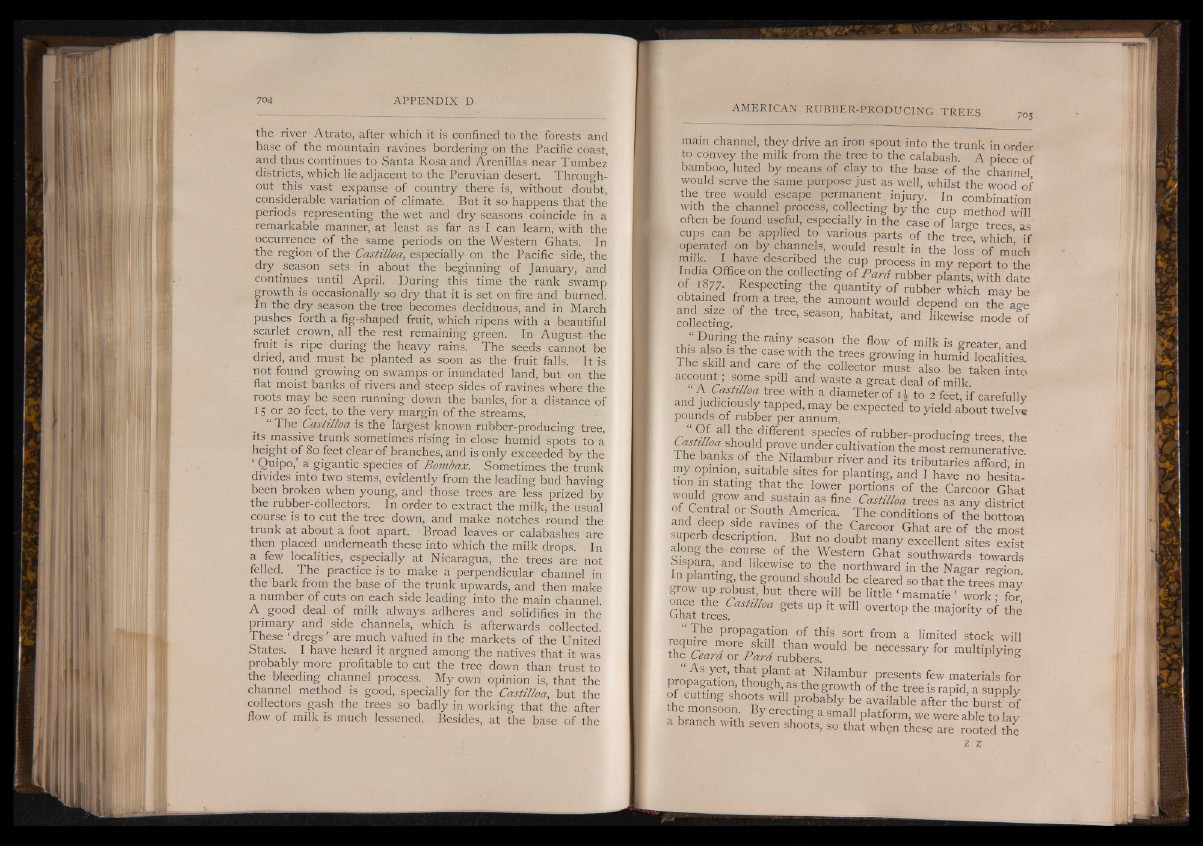
the river Atrato, after which it is confined to the forests and
base of the mountain ravines bordering on the Pacific coast,
and thus continues to Santa Rosa and Arenillas near Tumbez
districts, which lie adjacent to the Peruvian desert Throughout
this vast expanse of country there is, without doubt,
considerable variation of climate. But it so happens that the
periods representing the wet and dry seasons coincide in a
remarkable manner, at least as far as 'I can learn, with the
occurrence of the same periods on the Western Ghats. In
the region of the Castilloa, especially on the Pacific side, the
dry season sets in about the beginning of January, and
continues until April. During this time the rank swamp
growth is occasionally so dry that it is set on fire and burned.
In the dry season the tree becomes deciduous, and in March
pushes forth a fig-shaped fruit, which ripens with a beautiful
scarlet crown, all the rest remaining green. In August the
fruit is ripe during the heavy rains. The seeds cannot be
dried, and must be planted as soon as the fruit falls. It is
not found growing on swamps or inundated land, but on the
flat moist banks of rivers and steep sides of ravines where the
roots may be seen running down the banks, for a distance of
15 or 20 feet, to the very margin of the streams.
The Castilloa is the largest known rubber-producing tree,
its massive trunk sometimes rising in close humid spots to a
height of 80 feet clear of branches, and is only exceeded by the
‘ Quipo, a gigantic species of Bombax. Sometimes the trunk
divides into two stems, evidently from the leading bud having
been broken when young, and those trees are less prized by
the rubber-collectors. In order to extract the milk, the usual
course is to cut the tree down, and make notches round the
trunk at about a foot apart. Broad leaves or calabashes are
then placed underneath these into which the milk drops. In
a few localities, especially at Nicaragua, the trees are not
felled. The practice is to make a perpendicular channel in
the bark from the base of the trunk upwards, and then make
a number of cuts on each side leading into the main channel.
A good deal of milk always adheres and solidifies in the
primary and side channels, which is afterwards collected.
These I dregs ’ are much valued in the markets of the United
States. I have heard it argued among the natives that.it was
probably more profitable to cut the tree down than trust to
the bleeding channel process. My own opinion is, that the
channel method is good, specially for the Castilloa, but the
collectors gash the trees so badly in working that the after
flow of milk is much lessened. Besides, at the base of the
main channel, they drive an iron spout into the trunk in order
to convey the milk from the tree to the calabash. A piece of
bamboo, luted by means of clay to the base of the channel
would serve the same purpose just as well, whilst the wood of
the tree would escape permanent injury. In combination
with the channel process, collecting by the cup method will
often be found useful, especially in the case of large trees as
cups can be applied to various parts of the tree which’ if
operated on by channels, would result in the loss’ o f m ,U
milk. I have described the cup process in my report to S
India Office on the collecting of Para rubber plants, with date
° L l877j ResPecting the quantity of rubber which may be
obtained from a tree, the amount would depend on the aee
collectfng SGaSOn’ habitat’ and likewise mode of
During the rainy season the flow of milk is greater and
The S n i 1! S6 case w,ltb the trees growing in humid localities.
The skill and care of the collector must also be taken into
«°a n^ ’ SO,“ e spi11 a.nd waste a great deal of milk.
a iM M ! tree with a diameter of i | to 2 feet, if carefully
and judiciously tapped, may be expected to yield about twelve
pounds of rubber per annum.
“ Of all the different species of rubber-producing trees the
Castilloa should prove under cultivation the most remunerative
The banks of the Nilambur river and its tributaries afford in
my opinion, suitable sites for planting, and I have no hesita
' j f f i j stating that the lowe/portiols of the Carcoor G h S
nf r H W 1 1 l i H as fine B f i i f a trees as any district
and S °d America. The conditions of the bottom
and deep side ravines of the Carcoor Ghat are of the most
superb description. But no doubt many excellent sites Kris
along the course of the Western Ghat southwards towards
Sispara and likewise to the northward in the Nagar region
In planting the ground should be cleared so that the trees may
grow up robust but there will be little I mamatie ’ work : for
Ghat trees £ets UP R wdl overtop the majority of the
The Propagation of this sort from a limited stock will
equire more skill than would be necessary for multiplying
the Lear a or Para rubbers.
As yet, that plant at Nilambur presents few materials for
propagation, though, as the growth of the tree is rapid a supply
themonng p S Wl11 Probably be available after the burst of
the monsoon By erecting a small platform, we were able to lav
a branch with seven shoots, so that when these are rootedth l
z z